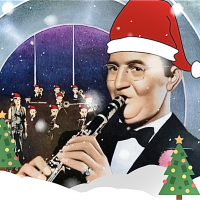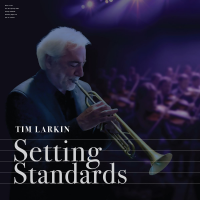Home » Jazz Musicians » Cab Calloway
Cab Calloway
The legendary "Hi De Ho" man was a energetic showman, gifted singer, talented actor and trendsetting fashion plate. A truly larger than life figure in American pop culture, immortalized in cartoons and caricatures, Calloway also led one of the greatest bands of the Swing Era. Consistently ranked among the top bands of the 1930s and 1940s, Calloway's orchestra entertained millions during its heyday, and the bandleader himself continued thrilling audiences up until the time of his death.
Born in Rochester, New York, Cab grew up in Baltimore. He studied music and voice as a youth, singing at local speakeasies when he could. Cab also excelled in sports. During his senior year in high school, he played for the Baltimore Athenians of the Negro Professional Basketball League. Torn between sports and music, he finally chose the latter. His mother, however, wanted him to follow his father's footsteps and become a lawyer. With that goal, Cab moved to Chicago to attend Crane College.
His older sister Blanche was already in Chicago, singing and dancing professionally. She helped Cab get a job with her in the musical review Plantation Days, when the show closed in 1927 Cab found a job singing at the Dreamland Cafe. In 1928 he went to work as the emcee of the Sunset Cafe, which also featured a house band called Marion Hardy's Alabamians. One day, during rehearsal, he decided to do a number with the band. They liked him so much they made him their leader. Cab dropped out of college to pursue a career as entertainer.
MCA signed the Alabamians in 1929 and sent them on a tour, which ended up in Harlem. The group flopped in New York, being perceived as ''unhip.'' The band decided to return to Chicago, but Cab remained in New York, where he took over as leader of a group called the Missourians. He left after only a brief time to return to Chicago, where he once again led the Alabamians. He soon returned to New York, where Louis Armstrong helped him get a spot in the Hot Chocolates review.
The Alabamians made a return engagement to New York late in the year, appearing at the Savoy Hotel, with Cab as leader. When the group returned to Chicago, Cab again remained behind and took over the Missourians. This time, he renamed the group as Cab Calloway and His Orchestra. They were booked into the Cotton Club in early 1931. The rest is history.
Read moreTags
Hi-De-Ho: The Life Of Cab Calloway

by David Rickert
Hi-De-Ho: The Life of Cab CallowayAlyn ShiptonHardcover; 288 pagesISBN 9780195141535Oxford University Press2010 During the swing revival of the 1990s it was singer and bandleader Cab Calloway, and not Benny Goodman or Duke Ellington or Glenn Miller, who provided the biggest influence--with the snazzy suits, hep language, and singer and band call and response that made Calloway famous. It was as if all you needed to do to form ...
Continue ReadingHarlem Jazz Shrines Fest: Cab Calloway Big Band At Alhambra Ballroom

Source:
Carolyn McClair Public Relations
Jazzmobile, Inc. Presents Alhambra Revived Featuring the Cab Calloway Orchestra at The Alhambra Ballroom May 9, 8:00 pm at the Third Annual Harlem Jazz Shrines Festival Harlem Jazz Shrines Festival Takes over Uptown May 6 - 11 Harlem, USA – The third annual Harlem Jazz Shrines Festival, a multi-venue partnership between The Apollo Theater, Harlem Stage and Jazzmobile, Inc., resurrects the spirits and sounds of Harlem’s historic jazz venues with swinging live performances May 6 – 11. On Thursday, May ...
read more
PBS' 'American Masters' to Air New Tribute to Cab Calloway for Black History Month

Source:
Something Else!
A new documentary on legendary bandleader and showman Cab Calloway will air on the PBS program “American Masters" as part of Black History Month. Cab Calloway: Sketches premieres nationally on Monday, February 27. Best known for his signature song “Minnie the Moocher," his inspirational role in the creation of Sportin' Life for Porgy and Bess, and his appearance in the 1980 film The Blues Brothers, Calloway died in 1994—but not before becoming a profound influence on figures as disparate as ...
read more
Cab Calloway's Legacy

Source:
JazzWax by Marc Myers
Having spent the day yesterday listening to Cab Calloway's recordings from 1930 to 1955, I began to wonder: Has Calloway been shortchanged? Does hip start with his records of the early '30s? Did he originate cool? Can jazz's with-it, knowing wink be traced back to his records of the early '30s? Calloway, of course, was the baton-waving bandleader with the tuxedo suits and tails, wide-brim hats, oversized mouth, unkempt hair and songs about Minnie the Moocher and Hi-De-Ho—all celebrated perfectly ...
read more
Big Bad Voodoo Daddy New CD Tribute to Cab Calloway

Source:
All About Jazz
BIG BAD VOODOO DADDY How Big Can You Get A Tribute to Cab Calloway In Stores Today!
America's favorite contemporary little big band, the award winning jumpin' jazz / retro swing Big Bad Voodoo Daddy, has released a new album entitled How Big Can You Get (Big Bad/Vanguard Records).
The 11 song CD, their eighth album, is a tribute to Cab Calloway, the legendary band leader and jazz singer, and was recorded in honor of what would have ...
read more
Big Bad Voodoo Daddy - Celebrate the Music & Legacy of Cab Calloway

Source:
All About Jazz
HOW BIG CAN YOU GET 100 Years of Cab Calloway featuring Big Bad Voodoo Daddy Celebrate the music & legacy of Cab Calloway Cab Calloway was a legendary fireball of talent, whose infectious hi-de-his, ho-dehos, scattin and jivin, in a baritone singing voice rich and vibrant, became the spirited cry of people wanting to be happy.
A truly larger than life figure in American pop culture, immortalized in cartoons and caricatures, Calloway also let ...
read more



































